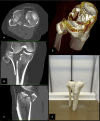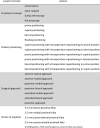3D printing improves preoperative decision making for patient positioning and surgical approach selection for tibial plateau fractures
- PMID: 40691693
- PMCID: PMC12280030
- DOI: 10.1038/s41598-025-11995-8
3D printing improves preoperative decision making for patient positioning and surgical approach selection for tibial plateau fractures
Abstract
Treatment of complex tibial plateau fractures remains a challenging task in clinical practice. Sufficient and appropriate preoperative decision making is essential for optimal treatment success and ultimately influences patient outcomes. Recently, the novel technique of 3D printing has proven to be beneficial for the preoperative management in other joint regions. To investigate the impact of point-of-care 3D printing on the preoperative management of tibial plateau fractures, we asked 5 students, 10 surgical residents, 3 junior surgeons and 4 senior surgeons, to simulate the preoperative planning of 22 tibial plateau fractures (11 AO B and 11 AO C fractures) regarding the treatment concept, patient positioning, operative approach and implant selection and positioning. First with CT scans only, second with 3D volumetric reconstructions, and finally with 3D printed fracture models. We analyzed the inter- and intraobserver agreement and the subjective perceived confidence of the rater regarding his decision with the different imaging modalities across the different levels of professional experience. Statistics were performed using kappa values, percentage match (PM) analysis and a univariate one-way analysis of variance. The use of 3D printing had no effect on the interobserver reliability of treatment concept selection (PM CT 83% > 3DCT 83% > 3D 82%). However, descriptively higher kappa and percentage match values increased for agreement on patient positioning and surgical approach using 3D printed fracture models. In addition, the raters selected the implants that were actually used to treat the fractures in 63% of the cases. The subjective perceived certainty of the raters increased with the use of 3D printing technology from 45% (CT and 3DCT) to 60% (3D). Additionally, raters changed their treatment plan in 36% of the cases and gained additional information 76% of the time when using the 3D printed specimen. The use of 3D printed fracture models showed a trend toward higher interrater reliability of patient positioning and surgical approach for medical students and surgical residents, while experienced surgeons show less benefit. In addition, 3D-printed models supported implant pre-selection and increased subjective confidence, positively influencing preoperative planning.
Keywords: 3D printing; Implant selection; Patient positioning; Preoperative management; Surgical approach; Tibial plateau fracture.
© 2025. The Author(s).
Conflict of interest statement
Declarations. Competing interests: The authors declare no competing interests. Ethical approval: The study was approved by the Ethics Committee of the Medical Chamber of Hamburg (ID: 2024-101279-BO-ff). Written informed consent was obtained from all participating raters prior to their involvement in the study.
Figures





Similar articles
-
The effect of addition of 2DCT scans and 3DCT scans for the classification of tibial plateau fractures: a systematic review.Eur J Trauma Emerg Surg. 2024 Feb;50(1):71-79. doi: 10.1007/s00068-023-02344-3. Epub 2023 Sep 28. Eur J Trauma Emerg Surg. 2024. PMID: 37768386 Free PMC article.
-
The influence of 3D printing on inter- and intrarater reliability on the classification of tibial plateau fractures.Eur J Trauma Emerg Surg. 2023 Feb;49(1):189-199. doi: 10.1007/s00068-022-02055-1. Epub 2022 Aug 9. Eur J Trauma Emerg Surg. 2023. PMID: 35941251 Free PMC article.
-
What Is the Patient-reported Outcome and Complication Incidence After Operative Versus Nonoperative Treatment of Minimally Displaced Tibial Plateau Fractures?Clin Orthop Relat Res. 2024 Oct 1;482(10):1744-1752. doi: 10.1097/CORR.0000000000003057. Epub 2024 May 9. Clin Orthop Relat Res. 2024. PMID: 38813973
-
Surgical fixation methods for tibial plateau fractures.Cochrane Database Syst Rev. 2015 Sep 15;2015(9):CD009679. doi: 10.1002/14651858.CD009679.pub2. Cochrane Database Syst Rev. 2015. Update in: Cochrane Database Syst Rev. 2024 Aug 22;8:CD009679. doi: 10.1002/14651858.CD009679.pub3. PMID: 26370268 Free PMC article. Updated.
-
A systematic literature review of tibial plateau fractures: What classifications are used and how reliable and useful are they?Injury. 2018 Mar;49(3):473-490. doi: 10.1016/j.injury.2018.01.025. Epub 2018 Jan 31. Injury. 2018. PMID: 29395219
References
-
- Raschke, M. J. & Herbst, E. Tibial plateau fractures: a lot more to come! Eur. J. Trauma. Emerg. Surg.46, 1201–1202. 10.1007/s00068-020-01551-6 (2020). - PubMed
-
- Meulenkamp, B. et al. Risk factors, and location of articular malreductions of the tibial plateau. J. Orthop. Trauma.31, 146–150. 10.1097/BOT.0000000000000735 (2017). Incidence. - PubMed
-
- van Dreumel, R. L., van Wunnik, B. P., Janssen, L., Simons, P. C. & Janzing, H. M. Mid- to long-term functional outcome after open reduction and internal fixation of tibial plateau fractures. Injury46, 1608–1612. 10.1016/j.injury.2015.05.035 (2015). - PubMed
-
- Honkonen, S. E. Degenerative arthritis after tibial plateau fractures. J. Orthop. Trauma.9, 273–277. 10.1097/00005131-199509040-00001 (1995). - PubMed
MeSH terms
LinkOut - more resources
Full Text Sources
Medical

